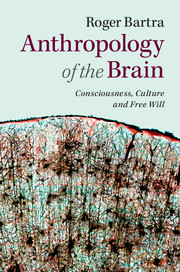Book contents
- Frontmatter
- Contents
- Preface
- Part I Consciousness and symbolic systems
- 1 The hypothesis
- 2 Evolution of the brain
- 3 Brain plasticity
- 4 Is there an internal language?
- 5 Amputations and supputations
- 6 The atrophied exocerebrum
- 7 The symbolic substitution system
- 8 Neuronal mirrors
- 9 Consciousness within hand’s reach
- 10 Outside and inside: the immense blue
- 11 The musical spheres of consciousness
- 12 Artificial memory
- 13 The lost soul
- Part II Brain and free will
- Bibliography
- Index
6 - The atrophied exocerebrum
Published online by Cambridge University Press: 05 June 2014
- Frontmatter
- Contents
- Preface
- Part I Consciousness and symbolic systems
- 1 The hypothesis
- 2 Evolution of the brain
- 3 Brain plasticity
- 4 Is there an internal language?
- 5 Amputations and supputations
- 6 The atrophied exocerebrum
- 7 The symbolic substitution system
- 8 Neuronal mirrors
- 9 Consciousness within hand’s reach
- 10 Outside and inside: the immense blue
- 11 The musical spheres of consciousness
- 12 Artificial memory
- 13 The lost soul
- Part II Brain and free will
- Bibliography
- Index
Summary
We can take another path to search for signs of the exocerebrum within the central nervous system. In certain illnesses an accentuated atrophy is observed in the relation between the mind of an individual and his or her sociocultural environment. It has been known for a long time that lesions in the prefrontal region of the brain provoke antisocial and psychopathic behaviors. The celebrated case of Phineas Gage, the worker who had an iron bar go through his head in an accident in New England in 1848 injuring his frontal lobe, was the emblematic beginning of study on the subject: Mr. Gage went from being a kind and reasonable person to becoming unbearably irascible with a permanent blasphemous, obscene, undisciplined, and aggressive behavior. Since then much information has been accumulated on the effects of prefrontal injuries. But now I wish to bring to my aid studies on antisocial people who have not suffered any injury. They are individuals who have been diagnosed by psychiatrists as having antisocial personality disorder: people characterized by continuous transgressive and violent behavior, constant aggressive irritability, and irresponsible indifference to the harm they inflict on others or on themselves. We can assume that these disorders involve communication defects between internal neuronal circuits that have atrophied and circuits of the exocerebrum. This interpretation is confirmed by research results: people with antisocial personality disorder, according to images revealed by structural magnetic resonance, showed a significant reduction of prefrontal gray matter (but not white matter). Very importantly, two other groups were also analyzed in this research: drug addicts and schizophrenics, or people suffering from affective disorders. There was no reduction of gray matter observed in these groups, who are also people afflicted with pathologies causing serious social problems.
- Type
- Chapter
- Information
- Anthropology of the BrainConsciousness, Culture, and Free Will, pp. 35 - 42Publisher: Cambridge University PressPrint publication year: 2014



